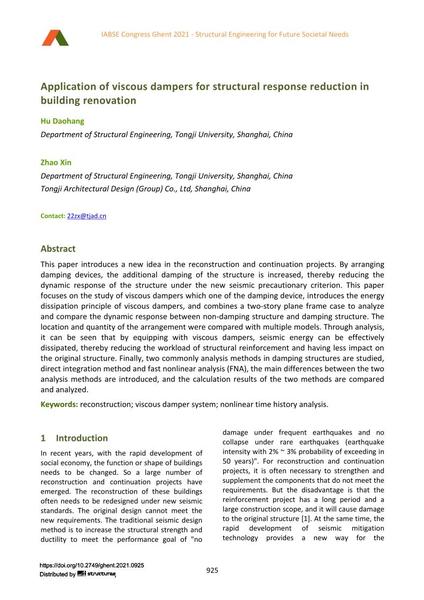Application of viscous dampers for structural response reduction in building renovation

|
|
|||||||||||
Détails bibliographiques
| Auteur(s): |
Hu Daohang
(Department of Structural Engineering, Tongji University, Shanghai, China)
Zhao Xin (Department of Structural Engineering, Tongji University, Shanghai, China Tongji Architectural Design (Group) Co., Ltd, Shanghai, China) |
||||
|---|---|---|---|---|---|
| Médium: | papier de conférence | ||||
| Langue(s): | anglais | ||||
| Conférence: | IABSE Congress: Structural Engineering for Future Societal Needs, Ghent, Belgium, 22-24 September 2021 | ||||
| Publié dans: | IABSE Congress Ghent 2021 | ||||
|
|||||
| Page(s): | 925-931 | ||||
| Nombre total de pages (du PDF): | 7 | ||||
| DOI: | 10.2749/ghent.2021.0925 | ||||
| Abstrait: |
This paper introduces a new idea in the reconstruction and continuation projects. By arranging damping devices, the additional damping of the structure is increased, thereby reducing the dynamic response of the structure under the new seismic precautionary criterion. This paper focuses on the study of viscous dampers which one of the damping device, introduces the energy dissipation principle of viscous dampers, and combines a two-story plane frame case to analyze and compare the dynamic response between non-damping structure and damping structure. The location and quantity of the arrangement were compared with multiple models. Through analysis, it can be seen that by equipping with viscous dampers, seismic energy can be effectively dissipated, thereby reducing the workload of structural reinforcement and having less impact on the original structure. Finally, two commonly analysis methods in damping structures are studied, direct integration method and fast nonlinear analysis (FNA), the main differences between the two analysis methods are introduced, and the calculation results of the two methods are compared and analyzed. |
||||
| Copyright: | © 2021 International Association for Bridge and Structural Engineering (IABSE) | ||||
| License: | Cette oeuvre ne peut être utilisée sans la permission de l'auteur ou détenteur des droits. |
||||
